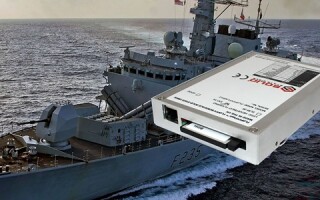GUEST BLOG: Questions about: SR-72 aircraft, 6G NGAD fighter plane, and B-21 Stealth Bomber
BlogNovember 26, 2024

WARFARE EVOLUTION BLOG: Let’s take a break from exploring the worldwide markets for military platforms in these essays, and connect some dots between the SR-72, the (Next Generation Air Dominance) fighter plane, and the B-21 Bomber. From the latest news reports, they all seem to be related. Dissecting each of these platforms should give us a better understanding of what’s going on inside the U.S. Air Force.
SR-72
The SR-72 Darkstar is the replacement for the SR-71 Blackbird spy plane that was retired in 1999. The Blackbird’s J58 afterburner engines could push it up to MACH 3.2 (2,400 MPH) at an altitude of 85,000 feet, with a range of more than 3,300 miles. That suggests that it had a combat radius of about 1,600 miles. The wing and fuselage surfaces were made from titanium, so they wouldn't melt from the heat generated by air friction at those speeds. In 1990, an SR-71 (tail number 972) flew from Palmdale, California to Washington (roughly 2,250 miles) in 1 hour 4 minutes and 20 seconds. The planes cost about $34 million each and 32 were built. Twelve were lost in crashes and accidents.
The SR-72 will fly at MACH 6 (4,600 MPH), at an altitude of 85,000 feet, with a range of about 3,000 miles (a combat radius of about 1,500 miles) according to speculation on the web. It will be powered by combined-cycle engines: turbofan-mode for supersonic speeds with scramjet-mode kicking-in at about 3,000 MPH for hypersonic speeds. (Supersonic speeds are MACH 1.2 to MACH 5; hypersonic speeds are MACH 5 to MACH 10; high-hypersonic speeds are MACH 10 to MACH 25). Flying from California to New York at Mach 6 would take about 30 minutes.
To read more Warfare Evolution Blogs by Ray Alderman, click here.
The surfaces of this aircraft will be built from carbon, ceramic, and some metal particles to withstand the heat from air friction. It looks like Lockheed Martin’s Skunkworks has started production of the SR-72. They have plans for an ISR version (intelligence, surveillance, and reconnaissance) as well as an armed version that can carry hypersonic missiles. And maybe an unmanned version that flies autonomously. First flight is predicted to be sometime in 2025. The design work, the composite materials, the new engines, and the construction of one aircraft is expected to cost a bit less than $1 billion.
NGAD
Back in July, Air Force Secretary Frank Kendall paused development of the new manned 6th generation NGAD (Next Generation Air Dominance) fighter plane and ordered a review. In September 2020, the Air Force announced that it had secretly built and flown an NGAD prototype test platform. Actually, three NGAD prototypes may have been built. This new fighter plane was slated to replace the F-22, that can fly at MACH 2.2 (1,500 MPH), as high as 50,000 feet, with a range of about 1,800 miles (and a combat radius of about 900 miles).
The Air Force planned to start ordering 200 NGAD fighters late this year, at a cost of about $300 million each, but that deal is off the table The NGAD was speculated to fly at MACH 3.8 or maybe MACH 5 (2,900 MPH to 3,800 MPH), at an altitude of maybe 60,000 feet, and a range of something better than 1,800 miles (about a 900 mile combat radius). The adaptive-cycle turbofan engines on the NGAD can control the airflow through the powerplant for either fuel efficiency in normal flight or high-power thrust for combat maneuvers. By comparison, the F-35 can fly at MACH 1.6 (1,200 MPH), at an altitude of 50,000 feet, with a range of about 1,300 miles (a combat radius of about 650 miles).
B-21
Next, we have the new B-21 Raider bomber. It can fly at MACH 0.8 (610 MPH). The Raider is a flying wing, and they become unstable above Mach 1. It can fly at an altitude of 55,000 feet with a range of about 2,500 miles (a combat radius of about 1,250 miles). Northrop Grumman has built six of the B-21s and the Air Force wants to buy 100. They cost $700 million each.
CCA
Let’s add another set of dots to this puzzle: the new “Loyal Wingman” drones or CCA (Collaborative Combat Aircraft). These are unmanned drones being built by Anduril (their Fury model) and General Atomics (their Gambit drone), that will fly alongside our fighter planes and bombers. The performance specifications for these aircraft have not been released, but speculation is that they will fly at MACH 0.95 (700 MPH), at an altitude of about 50,000 feet, with a range and combat radius a little better than manned fighter planes (maybe 700 to 800 miles combat radius). These wingman drones will cost about $21 million to $27 Million each, depending on how they are outfitted. The Air Force wants to buy 1,000 CCA drones.
Now, let’s do some math. We have 1,000 CCA drones at an average price of $25 million each, plus 100 B-21 bombers at $700 million each, plus 200 NGAD fighter planes at $300 million each. That’s $155 billion. The Air Force hasn’t said how many SR-72 aircraft they want, so let’s say five at $900 million each. That’s a total of $159.5 billion for all these aircraft over their acquisition lifetimes. The total Air Force budget for 2025 is $188 billion, for their people, their bases, their food, their planes, their fuel, and everything else.
As you suspected, there’s more to this story. All these new aircraft will need to be refueled in the air. Just look at their combat radiuses for verification. The radar cross section (RCS) of our present KC-135 tanker is probably about 100 square meters (the same as a B-52 bomber). The KC-46 tanker isn’t much better, so they are both big fat targets for enemy anti-aircraft missiles. If the enemy can destroy the tanker, the fighter planes and bombers can’t get fuel and must withdraw from the fight.
Obviously, stealthy fighter planes, bombers, and drones need a stealthy refueling tanker, so the Air Force is working on NGAS (Next Generation Air Refueling System). Lockheed Martin’s Skunkworks has released some artists renderings of what these planes might look like. The present cost of the KC-46 is $153 million each, according to the latest order for 15 placed in late 2023. The Air Force operates over 650 tanker planes today. We don’t know what a new stealthy tanker will cost.
There are also some operational problems to consider here. In a war in Europe, we will have airfields available in allied countries, so combat radius is not as limiting and air refueling demand will not be overwhelming. But in a war in the Pacific, we have the tyranny of distance: every location is more than 1,000 miles away from every other location, so combat radius and air refueling are critical elements. Short-range fighters work in Europe but we need long-range fighters in the Pacific.
Then, there’s Department of Defense (DoD) Directive 3000.09. It basically says that a human must pull the trigger on lethal weapons in a war (man in the loop), but the wording is ambiguous. It looks like fully autonomous weapons are fine for defensive operations, or where appropriate in offensive operations. We already have some of those systems: the AEGIS Combat System and the Phalanx System can operate autonomously. This directive suggests limits on what the Air Force can do with artificial intelligence (AI) and weapons on these new aircraft.
Air Force budgets are one problem, but there might be technical reasons why the Air Force is pausing the NGAD fighter program. Take the F-35 as an example. According to web sources, this fighter plane was designed with an engine bleed-air PTMS (power and thermal management system) that could handle 15 kilowatts of heat generated by onboard electronics, radar, electronic warfare systems (EW), and sensors. The latest version of the F-35 is generating 30 kilowatts of heat, pulling more bleed-air into the electronics for cooling and generating more electrical power, thereby wearing-out the engines faster. Next versions of the aircraft are planned for 62 kilowatts of cooling. After that, they want 80 kilowatts of cooling as they add more computers and AI algorithms.
One way to solve the cooling issues is to reduce the electronic systems on the NGAD fighter: get rid of the radar and sensor packages and receive targeting data from the sensors on satellites, ships, ground-based systems, and B-21 bombers flying nearby. That can be done with a few radios and a computer to fuse the data. They are looking at that in the Air Force’s “light fighter” concept. Better yet, why not just move the electronic systems in the fighter (radar, infrared, SATCOM, EW, etc) to the CCA drones flying nearby? One drone can do radar, another can do EW, another can do ISR, another can do SATCOM, another can carry weapons. And they can send data to the fighter plane with low-power radios on a local network. That’s called disaggregation. Each of those drones can handling the cooling for those separate electronic systems easily.
Another idea is to let the new B-21 bomber, with its long range, bigger weapons load, and stealth, handle some of the air dominance missions originally assigned to the fighter planes. Look at the new AIM-174 air-to-air missile in use on the Navy’s F/A-18 fighter. It has a range of about 250 miles. Since the B-21 is more stealthy than the F-35, or maybe the F-22, it can evade detection and hit enemy aircraft from BVR (beyond visual range). WVR (within visual range) for close combat between aircraft is just 12 miles.
That leads to a few more dots we can connect. Look at the AIM-XXX air-to-air missiles in use today, for air dominance missions. There’s the AIM-9 Sidewinder with a range of about 15 miles or so, which is great for WVR combat. The AIM-120 AMRAAM has a range of more than 30 miles, which makes it good for short-distance BVR combat. The Air Force is working on their AIM-260 missile, which will have a range of 120 miles (long-distance BVR), And we’ve already looked at the AIM-174, with a range of 250 miles (very-long-distance BVR). The obvious trend is that our fighter planes and bombers will destroy enemy aircraft from long distance BVR. There’s no reason to design a future fighter plane for dogfighting….or for a human pilot inside either. If you get rid of all the life-support systems, safety systems, expensive instrument display panels, ejection seat, and controls for the pilot, the aircraft can carry more fuel, more weapons, and cost much less. Plus, money is saved on pilot training.
So, let’s connect all the dots and look at the picture. We have five new platforms (the SR-72, the 6G NGAD fighter plane, the light fighter concept, the CCA drones, and the B-21 bomber) competing for parts of the air dominance mission. But, what works in Europe won’t work in the Pacific (based on speed, combat radius, weapons load, stealth, aerial refueling, etc). We have aggregation (ie, packing many electronic systems on one platform) competing with disaggregation (ie, spreading those electronic systems over multiple drones). We have autonomous air-to-air missiles with ranges that eliminate the need for dogfighting (and maybe fighter pilots) competing with DoD 3000.09 compliance on autonomous weapons. So, the Air Force is trying to decide which, and how many, of these new platforms they need for each potential war theater. That’s called the “High-Low Mix” problem. And whatever they decide, it has to fit within their budget. If you buy a small number of unique platforms for each theater, you have no economies of scale and the per-unit prices will be very high, taxing the budget. What the Air Force has on their hands is an incredibly challenging optimization problem.
The Navy is going forward with their new 6G F/A-XX fighter program, and they are already playing with the MQ-25 Stingray stealthy unmanned carrier-based refueling tanker. The Europeans are still going forward with their 6G fighter plane programs: the new Gripen fighter (Sweden, Hungary), the FCAS (Future Air Combat System) supported by France, Germany, Spain, and Belgium, and GCAP (Global Combat Air Program) supported by the UK, Italy, and Japan. These initiatives might run smack into the same heat problems we are seeing with the F-35 and start designing CCA drones for disaggregation. None of these countries fly long range bombers, so they don’t have the B-21 option as a targeting sensor node for nearby fighter planes.
That’s what I see going on with next-generation aircraft. There are other dots that are certainly important, but I ignored them to avoid complexity. Think of the picture painted here as a Picasso, not a Rembrandt. It will be interesting to see what the Air Force decides after their NGAD program review, and how the Europeans fare in their 6G fighter plane programs. Today, there are 14 European countries buying the 5G F-35 fighter plane. They cost about $83 million each, a bargain even with the cooling problems.
Next time, we’ll pull together all the worldwide military market data from previous articles and look at the trends. That won’t be as much fun as this article, but it has to be done.






